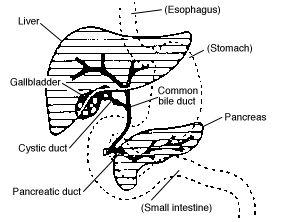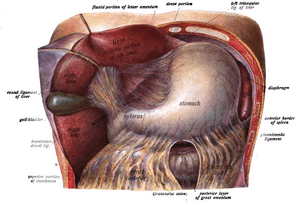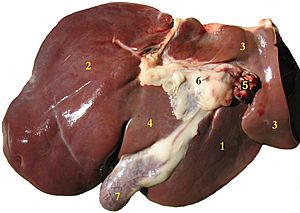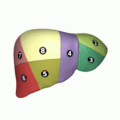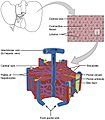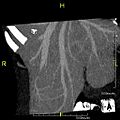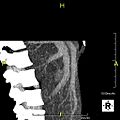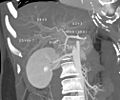Liver facts for kids
The liver is a very important organ found in your abdomen, which is the part of your body between your chest and hips. It's like a super-powered factory for your body! Sometimes, when people talk about the liver, they use words that start with hepar- or hepat-. The liver is the heaviest internal organ and the biggest gland inside the human body.
Contents
What the Liver Looks Like
The liver is a dark reddish-brown organ shaped like a wedge. It has two main parts, called lobes, which are different sizes. A human liver usually weighs about 1.5 kilograms (3.3 pounds) and is about 15 centimeters (6 inches) wide. Its size can vary a bit from person to person.
It sits in the upper right side of your belly, just under your diaphragm (the muscle that helps you breathe). It's also to the right of your stomach and on top of your gallbladder.
The liver is connected to two big blood vessels. One is called the hepatic artery, which brings fresh, oxygen-rich blood to the liver from your heart. The other is the portal vein, which carries blood full of digested nutrients from your whole gastrointestinal tract (your digestive system), as well as from your spleen and pancreas. These blood vessels split into tiny little tubes called liver sinusoids, which then lead to even smaller parts called hepatic lobules.
These hepatic lobules are like the liver's tiny working units. Each lobule has millions of hepatic cells, also known as hepatocytes. These are the basic cells that do all the liver's amazing work!
What the Liver Does
The liver has many super important jobs in your body:
- Making Bile: The liver makes a yellow-green liquid called bile. This bile goes into your small intestines to help you digest the food you eat, especially fats.
- Storing Energy: When you eat, the liver stores extra glucose (a type of sugar that gives you energy). When your blood sugar level drops, like when you haven't eaten for a while, the liver releases this stored glucose back into your blood to keep you going.
- Making Glucose from Other Things: If you don't have enough food, the liver can turn protein and fat into glucose. This is super helpful because it means your body can still get energy even if you're not eating.
- Making Fats and Cholesterol: The liver also makes some important fats and cholesterol that your body needs.
- Breaking Down Substances: The liver is like a filter! It breaks down (or metabolizes) many things in your blood, including:
- Storing Vitamins and Minerals: The liver keeps a supply of important vitamins and minerals for your body to use later.
- Making Important Proteins: The liver makes many different proteins, such as:
- Proteins that help your blood clot when you get a cut. These are called coagulation proteins.
- Proteins like albumin, which helps carry things in your blood and keeps fluids balanced.
- Making Red Blood Cells (in Babies): When babies are very small inside their mothers (as fetuses), the liver helps make red blood cells. Once you're born, your bone marrow takes over this job.
Liver Diseases
There are many different diseases that can affect the liver. When the liver gets sick, it can make a person very ill because it can't do all its important jobs. People with very bad liver disease might need a liver transplant. This is a special surgery where a sick liver is replaced with a healthy liver from someone who has recently died. It's a very difficult surgery, but it can save lives.
Signs of Liver Problems
The symptoms (signs) of liver disease happen because the liver isn't working properly.
When the liver can't break down toxins and waste, these bad things stay in the blood longer. One substance that builds up is called bilirubin. Bilirubin is a yellow substance that comes from old red blood cells. Normally, the liver removes bilirubin from the blood and puts it into bile, which then leaves your body with waste. If the liver is hurt, it can't remove the bilirubin, so it stays in your body. This makes a person's skin and eyes look yellow, a condition called jaundice. So, yellow eyes and yellow skin can be signs of liver disease.
Treating Liver Problems
Some liver diseases can be treated easily with medicine. For example, a condition called hemochromatosis is treated by taking blood from people every two months.
Some viruses that cause liver problems can be stopped before they even start! Two types of viral hepatitis (liver inflammation) can be prevented with immunizations (shots). Hepatitis A and Hepatitis B can be prevented with a few shots given over time.
However, some liver diseases are so severe that the only treatment is a liver transplant.
Liver as Food
The liver from animals like mammals, birds, and fish is often eaten by humans. You can find livers from pigs, cows, lambs, calves, chickens, and geese at butchers and supermarkets.
Liver can be cooked in many ways: baked, boiled, fried, or even stir-fried. In some cultures, it's even eaten raw! Some well-known dishes include liver pâté (a spread), foie gras, and chopped liver. Liver sausages, like Braunschweiger and liverwurst, are also popular meals or spreads. In South Africa, there's a traditional dish called skilpadjies, which is minced lamb's liver wrapped in a special kind of fat and grilled.
Animal livers are very rich in important nutrients like iron, vitamin A, and vitamin B12. Cod liver oil, which comes from cod fish livers, is often used as a dietary supplement because it's so nutritious. Historically, some fish livers, especially from stingrays, were considered a delicacy and used in fancy dishes.
Images for kids
-
Maksalaatikko, a Finnish liver casserole
See also
 In Spanish: Hígado para niños
In Spanish: Hígado para niños


